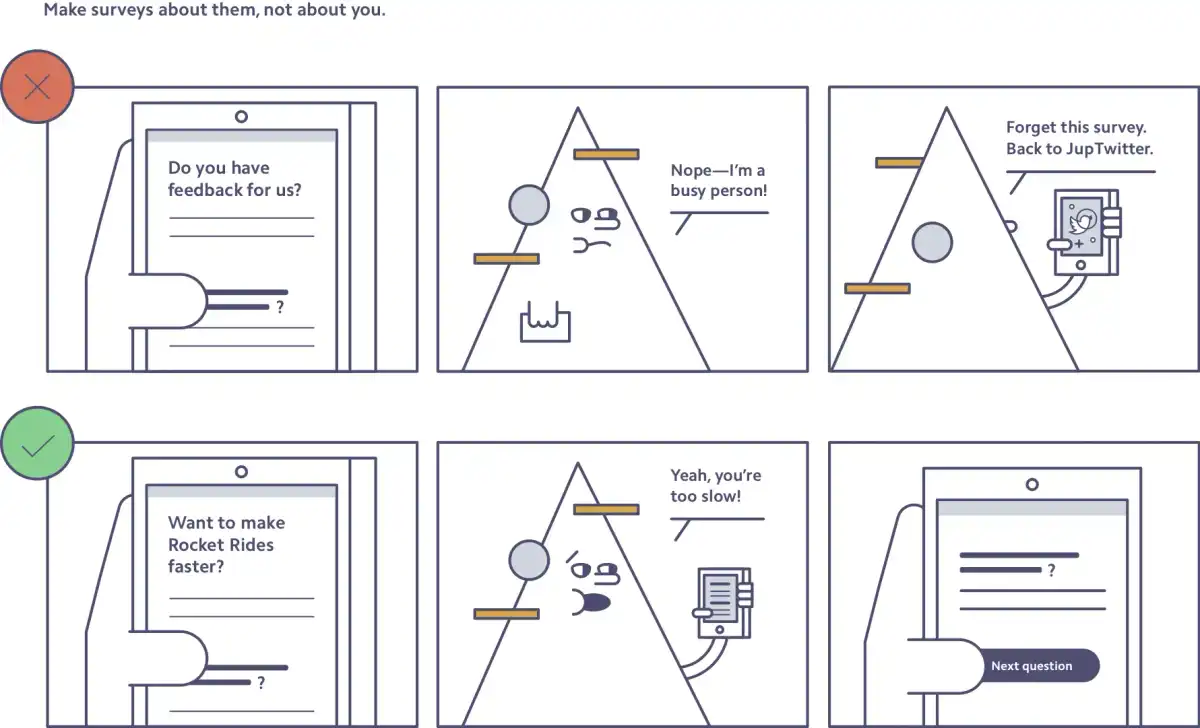5 Myths about democratizing research debunked by the Stripe Research Team
September 2021
·
7 min read

Democratizing research is a promising idea — as more people do their own research, research happens faster and at a much larger scale, ultimately enabling an organization to become more insight-driven. But with promise comes peril. Researchers often worry that democratizing research makes it more challenging to consistently maintain a high quality bar for research, and introduces the risk that researchers' hard-earned skills become devalued when "everyone can do research."
The research team at Stripe was well aware of these risks. Yet, they took the less trodden path and decided early on that everybody in the company could do research and invested in democratization from day one. Why and how did they do it? And what did they learn?
In this article, we're going to share the top 5 myths about democratizing research, debunked from first-hand experience by the research team at Stripe, and show you what actions you can take to manage the risks of democratization. Lastly, we will share our thoughts on the future of research democratization.
Myth 1: Non-researchers will flood the company with imperfect information
"If everybody starts doing research, non-researchers will flood the organization with low-quality information." This is one of the biggest reasons that keeps most companies from letting everyone do research.
Stepping back, the Stripe team realized that teams are making decisions without perfect information all the time. Teams at Stripe are constantly relying on log data, industry reports, and anecdotal information from conferences to inform their decision. A researcher can't magically appear and help provide every insight that's needed.
Even when a researcher is involved, they can't provide perfect information. Especially in the context of fast-paced businesses working with finite resources, researchers make trade-offs to manage quality, speed, and the actual needs of the business.
The real benefit of a researcher being involved is to understand when and where trade-offs are being made, and making everyone aware of risks that may be present with a given approach.
Given this, the Stripe team decided to let everyone do their research, and focused on creating the right UX infrastructure to help them do so. A key part of this is a research playbook that says "Okay, if you're gonna take on a basic research study, these are the things that you need to keep in mind and these are the steps that you're gonna take." The team has even open-sourced one part of their playbook — an in-depth guide to survey design available for anyone on Stripe Atlas.

That playbook then extends to a bunch of different frameworks that provide detailed guidance about how anyone executes research to ensure quality data for Stripe. The research team owns the playbook and regularly updates it to help improve everyone's research skills.
Lesson:
Instead of stopping non-researchers from doing research, empower them. Invest in a research playbook for the entire organization to get the essentials right.
Myth 2: Researchers are best positioned to elicit and land insights
When we first hear this myth, it sounds like a no-brainer. If someone's not trained in research, can they really produce valuable work?
According to Jillian Wells, UX researcher at Stripe, the answer is nevertheless a resounding "yes".
The reality in most companies is that the research team cannot support all the teams that need research expertise. Teams without research support end up making decisions about their products without any data. Even when a researcher does get involved, she has to spend a lot of time just ramping up on projects to get the domain knowledge needed.
At such a point, outsourcing to a vendor often feels like the best option. But even the very best vendors take time to ramp up on projects and "a lot of time" is something that startups don't have.
Seasoned engineers, product managers, or marketers are already domain experts. The level of knowledge they have is something that can take researchers months to gain. Plus the teams already know exactly what's important and why.
To address any concerns that non-researchers aren't in the right position to elicit insights, the Stripe research team focuses on understanding who the experts are in the company and encourages those people to go out there and do their own research.
To really facilitate this, they came up with the idea of organizing and hosting regular office hours. During these office hours, researchers share their expertise and provide guidance and review for research projects - increasing not just the quality of research, but also their peers' confidence. In addition, the research team also gets an opportunity to build relationships throughout the company.
Office hours also provide an unmatched opportunity for the researchers to identify if a project is too complex for non-researchers to take on and if the research team or a vendor should step in. As a result, the research team at Stripe can look at the big picture, and make sure that the person leading the research is the right fit.
Since Stripe has a distributed team, these office hours are a combination of physical meetings and zoom meetings scheduled during global-friendly times.
Lesson:
Create an effective learning and communication channel between researchers & the wider company. In Stripe's case, they use office hours to help anyone who needs guidance for their research. Researchers also leverage these conversations to gain a big picture of existing research and encourage more independent research efforts throughout the organization.
Myth 3: Democratizing research will leave researchers no time for their own work
Research democratization requires all hands on deck to build infrastructure. It makes sense that researchers would be worried about spending too much time on support and training, instead of strategic work.
But the research team at Stripe has discovered that investing their time in infrastructure, over time, has actually given them the space to work on the most impactful and strategic projects. Because teams can take care of their own tactical research needs, researchers can focus purely on strategic and high-impact initiatives.
Programs like "research playbook" and "office hours" take effort to get up and running, but they're what enables the Stripe research team to later focus nearly exclusively on the juicy stuff: high-impact, strategic research. The team also deploys a research tracker to stay on top of ongoing research initiatives across different teams. The research tracker helps both with efficiency and prioritization. The team can then focus on high-impact projects like "Mental Model Segmentation" and "Cross-organization Surface Design" while being a resource for other teams.
Lesson:
With the right UX infrastructure, researchers can not only support their co-workers doing research but also get the time back to focus on strategic, high-impact research.
Myth 4: Researchers will lose their edge
Researchers have invested time, energy, and study to develop their skill sets. If they are gonna come in and democratize research, there is a worry that their whole day might be spent talking about really basic things--like explaining card sort to a confused non-researcher.
Megan Witmer, now a Staff UX Researcher at Stripe, was definitely worried about this at the beginning. But over time, she has realized that becoming great at explaining research actually makes her a better researcher. It's an example of a well-known phenomenon, that teaching something is the best way of learning it.
Researchers at Stripe have even created a 20-hour "Research Champions" curriculum that teaches executives advanced research methods. The idea is to provide value to those who are either well-positioned or just particularly enthusiastic about research. This curriculum goes beyond the basic playbook which is available to everyone and provides more in-depth and empowering training.
Lesson:
Training others to do research makes researchers better at their craft. Teaching is the best way of learning, after all.
Myth 5: It'll make the research team obsolete.
The last myth about democratizing research is that it will put the researchers out of a job. Once everybody starts doing research, the company might start thinking that anyone can do it and not see the value of having a dedicated research team.
The researchers at Stripe have found this to be untrue: they haven't found any instances where non-researchers were taking over researchers' jobs. In fact, they've seen that democratizing research has increased the appetite and appreciation for research.
In a situation where there are fifty projects to be done for a tiny research team of four people, it is impossible to fulfill the heavy demand. At Stripe, researchers have tackled this problem by focusing on the sheer amount of research being done rather than who is doing it.
In this environment, the researchers can become more focused by prioritizing projects that create the most value for the company. They work with the leadership team to understand important questions that need to get answered and prioritize accordingly.
By working on mission-critical and visionary projects, the research team can deliver large-scale impact to the company. They were only able to do it because they've empowered other functions to handle day-to-day research needs.
Lesson:
Conducting research isn't the only way researchers provide value. Researchers can play a critical role in ensuring that research helps answer critical company-wide questions.
Final thoughts: The future of research democratization
This experience from Stripe (as well as other organizations like Google, Thumbtack, Slack, and more) shows us that with some effort, democratization of research can become a key strategic lever to grow research. That said, it is easier said than done, and there are significant risks one has to mitigate.
At Stripe, researchers have succeeded in creating a thriving democratizing research practice by focusing on key infrastructure -- research playbooks, training, and mentorship opportunities like office hours, as well as more in-depth training programs for research champions.
It's also clear that the Stripe researchers have found the process of democratization to be fulfilling and enriching to themselves as researchers. First, by becoming mentors, teachers, and research process debuggers, they have been able to hone their own craft and sharpen their edge as researchers. By letting the wider team handle more tactical and day-to-day research, they have also been able to focus on high-impact, strategic research. By hosting programs like office hours, and finding the time to work with leadership to really understand company-critical questions, they've also been able to create more in-depth and valuable relationships across the organization as well - ultimately creating a more research-driven culture.
As Stripe grows, we're very curious to see how the research team continues to evolve these practices around democratization.
Ultimately, the mission for research teams is to build an effective way to help their organization become more insight-driven, and the culture of the organization more user-centered. We've seen Stripe leverage the power of research democratization and establish infrastructure to achieve this mission.
This article is a recap of a talk given by Rawan Kaddoura, Jillian Wells, Megan Witmer, and Annie Steele, Research Team @ Stripe at the Research, Camera, Action! event hosted by Reduct at our office in San Francisco. Access the full talk and transcript here.


